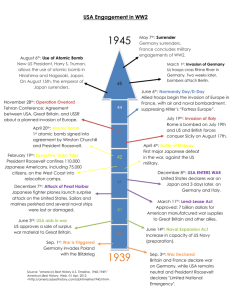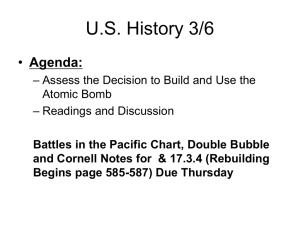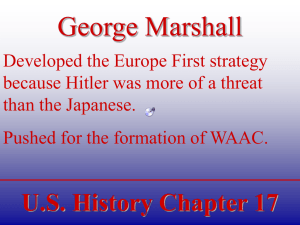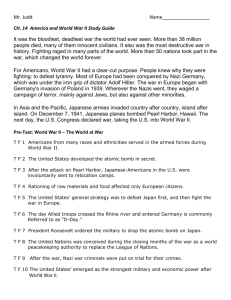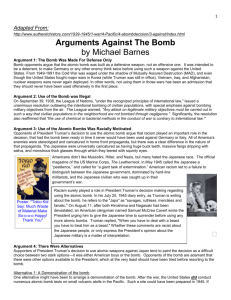Lesson
advertisement
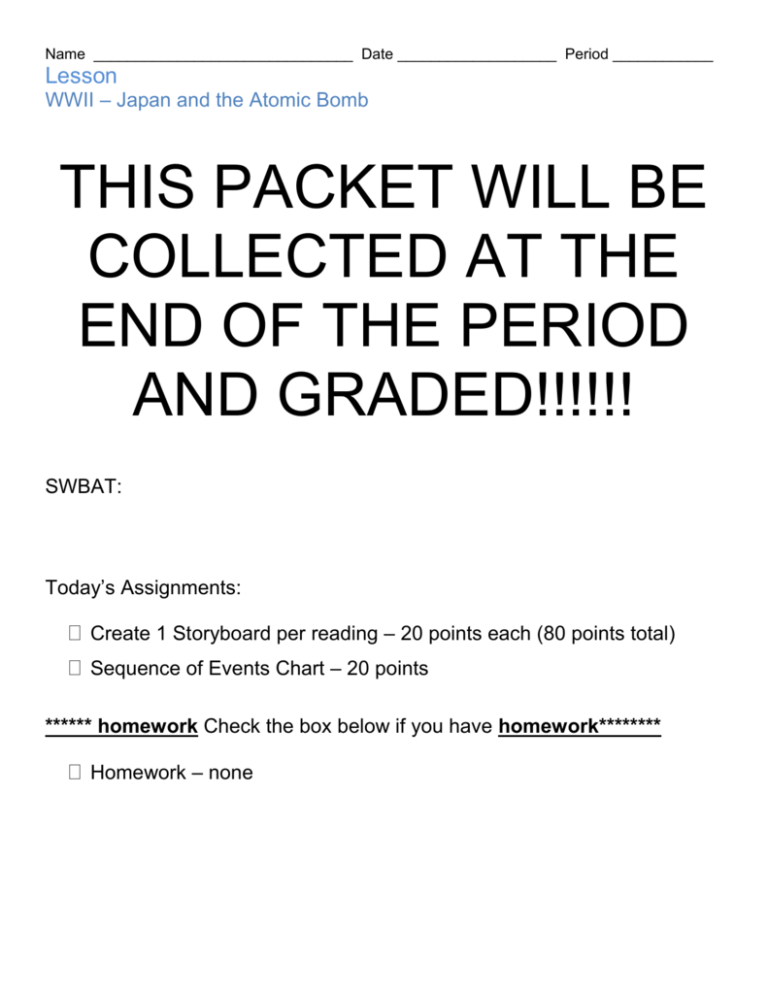
Name _______________________________ Date ___________________ Period ____________ Lesson WWII – Japan and the Atomic Bomb THIS PACKET WILL BE COLLECTED AT THE END OF THE PERIOD AND GRADED!!!!!! SWBAT: Today’s Assignments: Create 1 Storyboard per reading – 20 points each (80 points total) Sequence of Events Chart – 20 points ****** homework Check the box below if you have homework******** Homework – none Student Reading # 1 – excerpt from Ch 26 Sect 4 – The War in Japan – AGS Textbook 1. The Japanese government announced that it intended to rule all of Asia, including China. 2. That type of control went against America's open door policy in China (all nations would be allowed free trade with China) 3. America protested Japan's actions. 4. Japan continued its plan to create an empire. 5. Japan joined Germany and Italy in its alliance and became known as the axis powers. 6. Japan invaded Southeast Asia (Indochina) 7. The United States became concerned that Japan was gaining too much land. Vocabulary a group of nations ruled by a single authority Empire – Axis powers – the alliance of Japan, Italy, and Germany in World War II 8. America decided to stop selling oil and steel to Japan. 9. Japan desperately needed oil to continue with its plan. 10. When Japan invaded Indochina, Roosevelt said Japan could not use money or investments it had in the United States (froze assets) 11. Japan did the same thing to the United States. Trade between the two countries stopped. Student Practice # 1 – Storyboard for Reading # 1 20 points Instructions 1. 2. 3. 4. Write a Title Write 3 facts in your own words Write 1 question Draw a picture representing the text Storyboarding is a strategy requiring students to sequence a series of events or concepts by writing summaries, creating illustration, and posing questions. This activity helps students develop chronological and cause –and-effect relationships between events. Student Reading # 2 – Excerpt from Ch 26 Sect 4 – The War in Japan – AGS Textbook Why did Japan attacked Pearl Harbor? 1. On early Sunday morning, December 7, 1941, 353 Japanese airplanes took off from six aircraft carriers in the Pacific Ocean. Word Bank Infamy – an evil deed known to all; disgraceful or lacking honor 2. Their destination was the American naval base at Pearl Harbor, Hawaii, 220 miles away. 3. Their mission was to destroy the American naval fleet anchored there. 4. The Japanese thought they would be better able to conquer land in Asia if these American ships were destroyed 5. The surprise attack occurred at 7:55 AM. 6. Two hours later, the United States Pacific Fleet had lost many battleships, destroyers, and planes. The attack killed more than 2000 Americans. 7. Roosevelt said that December 7, 1941, was a "date that will live in infamy." 8. Japan followed up its attack on Pearl Harbor by invading the Philippine Islands and other areas in the Pacific. 9. American and Filipino troops fought the Japanese. However, they lacked planes, tanks, and ammunition. 10. Japan now controlled the Philippine Islands. Student Practice # 2 – Storyboard for Reading # 2 20 points Instructions 1. 2. 3. 4. Write a Title Write 3 facts in your own words Write 1 question Draw a picture representing the text Storyboarding is a strategy requiring students to sequence a series of events or concepts by writing summaries, creating illustration, and posing questions. This activity helps students develop chronological and cause –and-effect relationships between events. Student Reading # 3 – Excerpt from Homework – Ch 26 sect 5 – The Home Front How were Japanese-Americans treated during the war? 1. The United States feared that Japan would invade it's west coast. 2. Some citizens thought people of Japanese ancestry living in America would aid the Japanese. 3. President Roosevelt ordered the army to move about 110,000 of these people to Internment Camps. 4. Many Japanese-Americans lost their homes and businesses. Word Bank Internment – the imprisonment of people or groups without a trial detained – to restrain or keep somebody in custody 5. Fear, the pressure of war, and prejudice caused the nation to set aside it's democratic principles. 6. Japanese – American soldiers fought bravely in Europe while their government detained their parents and relatives. Student Practice # 3 – Storyboard for Reading # 3 20 points Instructions 1. 2. 3. 4. Write a Title Write 3 facts in your own words Write 1 question Draw a picture representing the text Storyboarding is a strategy requiring students to sequence a series of events or concepts by writing summaries, creating illustration, and posing questions. This activity helps students develop chronological and cause –and-effect relationships between events. Student Reading # 4 – excerpt from Homework – Chapter 26 Section 6 – The War Ends Vocabulary 1. The United States began fighting the Japanese military. 2. Despite their losses, the Japanese refused to surrender. 3. The Allies began to plan and invasion of Japan. 4. President Truman learned that the U.S. had developed the Atomic bomb – a bomb with great destructive powers Cease – fire – a call for an end to fighting atomic bomb, or the A–bomb. 5. This bomb could end the war, but take many Japanese lives. 6. Truman was advised that over 1 million American soldiers lives and countless Japanese people would be lost in a land invasion of Japan. 7. The president gave one last warning to Japan before using the A-bomb. 8. Japan refused to surrender 9. The atomic bomb was dropped on the city of Hiroshima. 10. That weapon destroyed the city and instantly killed or wounded 130,000 people. 11. Three days later, a second atomic bomb was dropped Nagasaki, killing or wounding 75,000 people. 12. On August 14, 1945, Japan asked for a cease – fire. 13. On September 2, 1945. World War II, the worst war in history, was finally over. Student Practice # 4 – Storyboard for Reading # 4 20 points Instructions 1. 2. 3. 4. Write a Title Write 3 facts in your own words Write 1 question Draw a picture representing the text Storyboarding is a strategy requiring students to sequence a series of events or concepts by writing summaries, creating illustration, and posing questions. This activity helps students develop chronological and cause –and-effect relationships between events. Sequence of Events 20 points Directions: List the events that happened to Japan during WWII First Event Japan imperializes China Next Next Next Next Next Last The US defeats Japan in WWII

